Sorry for being late with this. Real life, and all that. We’ll be back on track with “Genesis” on Friday.
“Eye of the Beholder”
Written by Brannon Braga and Rene Echevarria
Directed by Cliff Bole
Season 7, Episode 18
Production episode 40276-270
Original air date: February 28, 1994
Stardate: 47622.1
Captain’s Log: One of the nacelles is malfunctioning. Riker and Worf discover that Lieutenant Daniel Kwan is threatening to jump into the plasma stream. Riker tries to talk him down long enough for Worf and Lieutenant Nara to shut it down, but they’re not fast enough. After rambling on about people laughing at him and such, Kwan says, “I know what I have to do,” jumps into the plasma stream, and is incinerated.
The crew is devastated. Riker wishes he had a few more seconds, and says that Kwan seemed fine just the other day when the nacelle refit was finished. Picard has never had to do a death notification to a family member where it was a suicide. He puts Worf and Troi in charge of the investigation into Kwan’s death.
They find a picture of Ensign Calloway by his bed, and his last personal log is simply expressing pleasure that the nacelle refit was done and he was looking forward to spending time with Calloway. Troi talks to both Calloway and Nara, who was his supervisor, and they are just as shocked and confused by all this. Calloway describes him as sensitive and happy, Nara as ambitious and a good worker; neither has any idea why he killed himself.
When she walks toward the plasma stream, Troi gets an intense empathic impression of fear, rage, and panic from—well, nobody. Kwan’s mother was Napean, a telepathic species, so it’s possible that the impressions are left over from him.
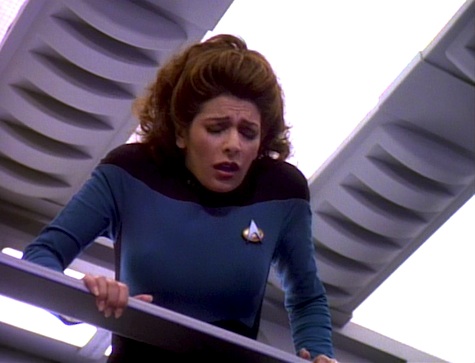
Worf checks on Troi, who still finds nothing in Kwan’s personal logs to indicate why he did this. After the two of them have a pleasant conversation, Worf suddenly gets antsy and leaves, going to Ten-Forward, where he makes the lamest attempt to ask for Riker’s permission to date Troi it’s possible to make.
Later, Troi again visits nacelle control, and this time she sees a man and a woman in engineering jumpsuits, the woman scared and screaming, the man angry—and then Troi finds herself still in nacelle control, but when the Enterprise was still at the shipyards. She walks in on two people making out, one of whom is the woman she saw screaming, but she’s smooching with a different man—they both start laughing—
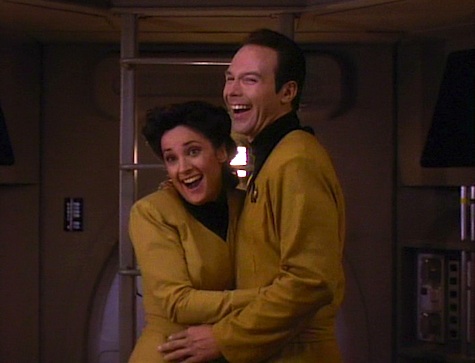
—and then Troi’s back in the present, with Worf getting her attention.
Troi recalls only bits and pieces of what happened, and she has no idea who the woman or the man smooching her are, but the other man looks vaguely familiar. Crusher will synthesize an inhibitor that will allow Troi to go back to nacelle control without being overwhelmed, and then maybe she can pick out more details. But it’ll take time to find, so meanwhile Troi goes through the personnel records of Utopia Planitia from eight years earlier when the Enterprise was being constructed. She finds the angry man, Lieutenant Pierce, who transferred back to the Enterprise six months earlier and is now serving in engineering. He and Kwan both worked together at Utopia Planitia.
Worf and Troi question him, and he professes ignorance about anything that might have happened eight years earlier—but they both know he’s holding something back, the former from his security training, the latter from her empathic abilities. Pierce can actually block Troi’s empathy, which is odd from a human. The two retire to Troi’s quarters, and then they smooch and fall into bed together.
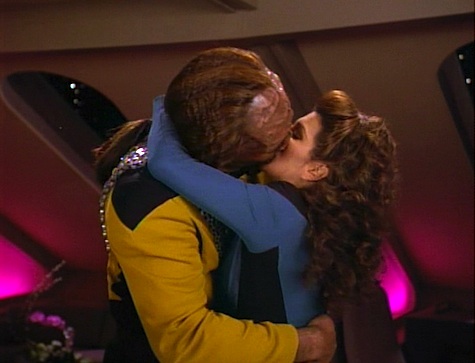
The next morning, Crusher gives Troi the inhibitor, but Worf can’t accompany her to nacelle control right away due to issues with the medical supplies the ship is transporting. Worf is assisting Calloway, and they seem almost flirtatious, which irks Troi a bit.
At nacelle control, Troi asks about a plasma conduit, which it turns out Kwan was working on the day before he died. Nara also says that that was the first time that conduit had been opened since the ship was built.
As soon as La Forge opens the panel at Troi’s request, she sees the woman screaming again, with Pierce standing over her. Data and La Forge detect organic matter in the bulkhead—and they find a skeleton. Extracting it from the wall, the bone fragments are brought to sickbay. Crusher says they’ve been in the wall for seven or eight years, and Calloway starts comparing the DNA profile to Starfleet records. Worf stands over her, again irking Troi.
The DNA matches Ensign Marla Finn, who was declared missing from the shipyards eight years earlier. But Kwan didn’t report to Utopia Planitia until six months after Finn’s death, so Troi can’t have been seeing through Kwan’s eyes. Then she realizes that her impression of Pierce was a reflection—she saw through his eyes. Worf goes to talk to Pierce again while Troi, who’s a bit out of it from the inhibitor, goes to her quarters.
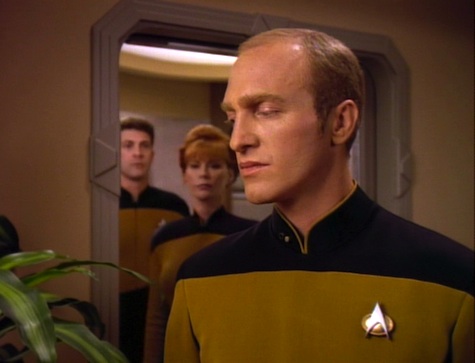
Then Pierce shows up at her door. Troi calls security, which confuses Pierce, as Worf told him to report to her. Troi asks the computer to locate Worf—who is in Calloway’s quarters. She has the security team that shows up escort Pierce to his quarters to hold him there, and Troi then heads to Calloway’s cabin, only to find Worf and Calloway smooching. And then they laugh at her, the same way Finn and the other man did in her earlier vision. Angry, Troi grabs a phaser and shoots Worf, killing him. Troi runs through the corridors—bumping into Pierce, who smiles and says, “You know what you have to do”—and then heads to nacelle control. Just like Kwan, she says, “I know what I have to do.”
But before she can jump, Worf grabs her and pulls her back. It turns out that everything that happened since she first hallucinated Utopia Planitia was in her mind and only took a few seconds of real time. Data digs up the shipyard records, and finds that Pierce, Finn, and the other guy were all killed in what was considered an accident. Pierce is a quarter Betazoid, which makes him telepathic enough to have left an impression in the plasma stream when he died. Troi guesses that Pierce found out that Finn and the other one were having an affair, and he killed them and then staged the accident to a) commit suicide and b) cover up the evidence of his murder.
Can’t We Just Reverse the Polarity?: Apparently, if someone who’s one-quarter telepathic is incinerated by a plasma stream, it leaves enough of a psychic residue to make anyone else who’s telepathic be so overwhelmed by said residue that they will commit suicide also. Which kinda sucks for them.
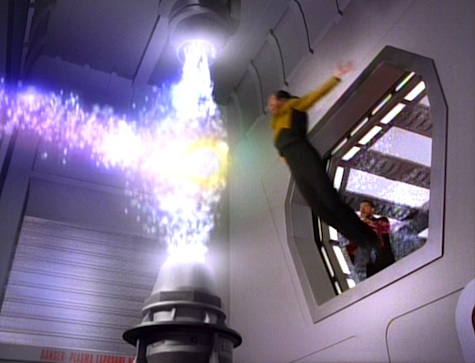
Thank You, Counselor Obvious: Troi spends half the episode in a fugue state where she gets to knock boots with Worf, find him in the arms of another woman, and then kill him.

If I Only Had a Brain…: Data reveals to La Forge that he, after a fashion, considered suicide. Shortly after his activation, he struggled with sentience, risking cascade failure with each new neural pathway created in his positronic brain. The difficulties led him to contemplate shutting himself down and starting over, but he decided that these were challenges to be overcome rather than obstacles to be avoided.
There is No Honor in Being Pummeled: Worf is seriously considering courting Troi following the events of “Parallels,” but he doesn’t feel comfortable doing so without Riker’s blessing. However, his attempt to get that blessing is awkward and ridiculous and hilarious.
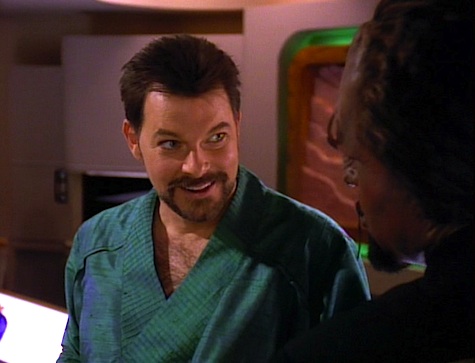
No Sex, Please, We’re Starfleet: There’s quite a lot happening sexually in this episode. Kwan and Calloway had a pretty strong relationship, and she’s confused by his suicide (it’s possible she’s also devastated, but Johanna McCloy utterly fails at conveying that). Riker is making the moves on a Lieutenant Corell in Ten-Forward. Worf starts making the first tentative steps toward possibly seeing Troi romantically, which Troi has picked up on enough of to have it influence her hallucination, and she and Worf do the deed. Then, later in the hallucination, Worf and Calloway are smooching. And the whole mishegoss started because of an affair Finn and another guy had when Finn was dating Pierce back on Mars. Wah-hey!
I Believe I Said That: “Well, you know what they say, Mr. Worf: hell hath no fury like a woman scorned.”
Troi’s response to Worf’s question of how he was killed in her hallucination, which she answers by misquoting William Congreve. (The actual quote from The Mourning Bride: “Heaven has no rage like love to hatred turned, / Nor hell a fury like a woman scorned.”)
Welcome Aboard: Nancy Harewood and Johanna McCloy are barely adequate as Nara and Calloway, respectively—though I would’ve expected the love of Kwan’s life to be a lot more broken up. I mean, Jonathan Frakes showed more emotion over Kwan’s death than the woman playing his girlfriend. As Kwan, Tim Lounibos does the best he can with a part that just calls for him to stand in place muttering seeming nonsense before jumping. Longtime extra Nora Leonhardt gets something resembling a speaking part—no dialogue, but she gets to scream and laugh—as the image of Finn. (Amusingly, Leonhardt also was Marina Sirtis’s usual stand-in, but her role as Finn kept her from doing that this episode, so that role went to Second Assistant Director Arlene Fukai.)
But this episode’s Robert Knepper moment is longtime character actor Mark Rolston, who has made a career playing hardasses and nasty folks, as Pierce.
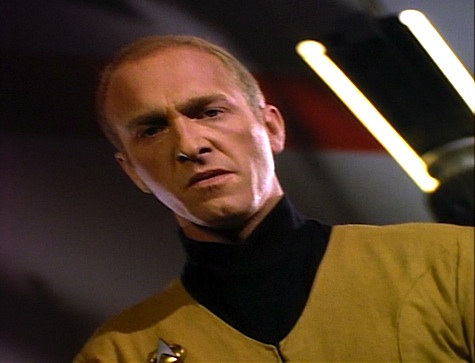
Trivial Matters: The Utopia Planitia Fleet Shipyard was first referenced (and seen in holographic form) in “Booby Trap.”
Troi references talking to Kwan during the crew evaluations, which occurred in “Lower Decks.”
Picard says that the warp speed limits are suspended for their medical mission, yet another reference to “Force of Nature” for the express purpose of working around what that episode established.
Worf mentions seeking visions in fire, something we saw him try in “Rightful Heir,” both in his quarters and on Boreth.
Make it So: “They laughed at me!” This isn’t a bad episode, exactly. It’s an interesting little mystery that has a science fictional twist, though the upshot that telepaths are helpless before the power of eight-year-old psychic residue is a little—odd? I mean, seriously, Kwan and Troi both were driven to take their own lives just from the impressions of Pierce’s murder-suicide?
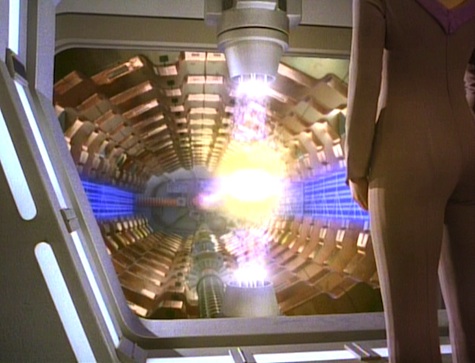
I had misremembered that all of this episode was in Troi’s head, but it’s only about half of it. For one thing, that means that Worf’s awkward conversation with Troi followed by his hilarious attempts to ask for Riker’s permission really did happen, which is a nice bit of progress on that front, and I loved Data’s admission to La Forge that he considered a form of suicide early on after his activation. (I also like the way Data folds his arms the same way La Forge does when he confides in him.) In addition, in a surprising twist for TNG, the ending is kind of unresolved. There’s no way to prove what happened on Utopia Planitia, and it wouldn’t much matter anyhow, since the person responsible is also dead. I would’ve liked to have seen more done with the consequences here—I mean, Pierce managed to, in essence, commit another murder eight years after he died. That would seem to be worth talking about.
Still, overall, I get a sense of meh. The guest casting doesn’t help—Johanna McCloy is pretty nowhere as Calloway, and just the act of casting Mark Rolston kinda points to Pierce being our bad guy.
Warp factor rating: 5
Keith R.A. DeCandido has two new books out, neither of which are actually SF/F: the novel Leverage: The Zoo Job, based on the TV series about criminals who help people, and the baseball book In the Dugout: Yankees 2013, which he co-edited with Cecilia M. Tan, all about New York’s American League baseball team.










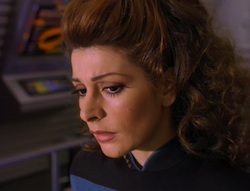
Honestly, I couldn’t even push play I remember this one being so bad.
I keep getting the name Mark Rolston confused with Mark Raxton, the Molten Man from Spider-Man comics. Although the main role I know Rolston from is the voice of Lex Luthor on Young Justice.
This episode is an example of how the Next Generation Technical Manual was influencing the writing/production by this point, because the depiction of the nacelle interior is very similar to what’s in that book — although they simplified it by, rather nonsensically, having only one plasma injector for the whole nacelle, rather than one for each warp coil as in the manual. I guess that was cheaper to animate. Still, it’s neat to see a nacelle from the inside. Except that I’ve always found it implausible that a warp nacelle, especially an active one, could be a place where crewmembers could actually occupy and work in. I mean, Matt Jefferies’s basic rationale in putting the engines in outboard nacelles on long pylons was the assumption that they’d give off so much radiation that it wouldn’t be safe to get anywhere near them while they were active. Not to mention the sheer heat given off by that plasma stream. Even if we accept the ridiculous pretense that a thin, invisible forcefield is able to block all that stellar-level heat and radiation, Kwan should’ve vaporized the instant he stepped through the field, before even getting to the actual plasma stream. Nobody who makes TV or film has a clue when it comes to thermodynamics.
And that’s really the one thing that’s stood out in my mind about this episode — except for the realization that if Roddenberry had still been alive at this point, he wouldn’t have allowed a story about Starfleet officers involved in sexual betrayal, jealousy, murder, and suicide. Usually Rick Berman was pretty emphatic about keeping the franchise true to those parameters, so it’s surprising to see them so severely bent here. Maybe the fact that the culprit was so far in the past (although only a year before the start of the series) made it more acceptable.
I always wondered why this sort of thing hadn’t happened before, since it seems like such a strong effect. Also, how does it get cleaned out? What exactly *is* psychic residue?
…and isn’t a plasma stream an ever-changing sort of thing? How does *any* part of it last for eight years?
It just struck me as a goofy ghost/paranormal story that stumbled into the Trek plot cannon. It’s not awful, it’s just… kinda dumb.
This is the episode that, in my mind, finally bridged the Engineering set design from the original series to the movie/TNG era. Engineering on the original Enterprise seemed to consist of a control room and a large chamber behind a fence or screen ( http://en.memory-alpha.org/wiki/Engineering ). As as kid, I never understood the change to the multi-story tubes seen in later versions. Seeing this episode I had the “epiphany” that they’d spent all those TOS episodes in the nacelle control room. Now I’m sure CLB will correct me. But it made sense at the time. :D
This was among the first new episodes I saw back in 1994 after having missed chunks of seasons 5 and 7 and all of 6 because I was out of the country. I found the mystery and resolution fairly compelling, but don’t recall the flat acting. I need to watch this one again.
BTVS did this much better.
I think the best equivalent of the TOS engineering set is the part of the TNG set with the pool table. Basically a control room for the big machines that are elsewhere. Imagine the TNG engineering set with a big metal screen blocking the pool table area from the shiny pulsing light tube. And really, in TOS they hadn’t thought any farther than “room with control panels”. Take the dilithium chamber. In TNG, the matter/antimatter anihilation reaction takes place inside the dilithium crystal lattice, inside the warp core. In TOS, the dilithium chamber is a cabinet with sliding drawers and the crystals can be pulled out with a handkerchief.
@3: The residue that generated the psychic impression was embedded in the wall panel near the plasma stream, not in the plasma stream itself.
@@.-@: The Constitution-class cutaway seen onscreen in ENT: “In a Mirror, Darkly” (or rather, this clearer version thereof) shows the engine room in the secondary hull, just in front of where the nacelle pylons meet the ship. The angled “tubes” behind the grille are interpreted there as the plasma conduits running from the horizontal warp core beneath the floor of the engine room up to the nacelles. (In my novel Department of Temporal Investigations: Forgotten History, I describe the bowels of the engineering section in a way that combines/reconciles that cutaway with information from the animated series.)
@6: You seem to be describing the engineering set from “The Alternative Factor,” an episode whose depiction of dilithium and antimatter is so contradictory to the rest of TOS that it pretty much has to be dismissed as apocryphal. It treated dilithium as the ship’s power source, while antimatter was a phenomenon from another universe that would completely destroy both universes if it ever came in contact with identical matter. But previous and later TOS episodes consistently depicted the ship as matter-antimatter powered with the (di)lithium crystals as the means by which that power was routed to ship’s systems. It was eventually established that the dilithium crystals were contained within (or at least accessed through) the freestanding unit in the middle of the engine-room set, as seen in “Elaan of Troyius,” for instance. The Drexler cutaway has that unit as the “tip of the iceberg” of the warp reactor underneath, so I assume the frame that rises from the top of the unit with the crystals inside is just the top of a sort of elevator shaft that lowers them into the reactor proper.
When I watched this I actually thought the Worf/Riker conversation was in her head too, I was a bit confused at what was real and what was not. Which is partially why I did start off liking the episode and interested in the mystery, but felt just a bit cheated at the end. I’m not a big fan of ‘it was all a dream’ type endings.
Also, Pierce scared me just by looking at him, and that was before I realized he was the creepy prison guy in Shawshank Redemption.
I think CLB makes a good point though about this type of story being alien to the kind of thing Roddenberry envisioned for his universe. I have not come to a strong opinion if I think that is automatically a terrible thing or not, though.
@7 Great stuff, thanks. The horizontal warp core explains why it’s not visible in TOS, but then the question comes as to why they made it vertical. Other than Rule of Cool.
@6 Imagining a screen blocking the view of the reactor would make sense, if it weren’t clear—no pun intended—that the screen in the original series Engineering set was transparent or a latticed fence. (If I am not mistaken, there was some forced perpective involved, too.) You’re right, though; the location of the pool table is definitely the analog of the original Main Engineering.
My main thoughts on watching this was seeing Mark Rolston and thinking “that’s the serial killer guy from Babylon 5, he’s bound to be the baddie.” Other than that it left very little impression, except some vague thoughts about the physical logistics of Klingon/Betazoid sex.
@9: Yes, the “cathedral” of pipes behind the grille in TOS engineering was a forced-perspective effect, with the pipes getting progressively smaller and closer together with distance to make it look like they were parallel but extending much further back. The same technique was used in ST:TMP’s engine-room set to make the horizontal intermix shaft seem to stretch much further back — with the added effect of putting Little People in engineering uniforms at the back.
One of the reasons I’ve never been crazy about Franz Joseph’s TOS blueprints is that he totally missed the point of the forced-perspective piece and drew it as a section that actually did taper inward. He also put the engine room in front of the impulse engines rather than the warp engines, which makes no sense given that the dilithium crystals were right there. (It could be said to make sense given the way the curved corridor set led to the engine room, but the FJ blueprints don’t even depict that accurately!)
BTVS did this plot much better.
When I saw the episode I also believed it was all in Troi’s head (not just misremembering it now, I had interpreted it wrong even when watching it) which had made me very confused and not like the episode very much. Except for the Riker/Worf exchange which seemed even funnier that way because of how goofy her fantasy-Riker was, and that with Worf’s over-formality made them both slight caricatures of themselves, which made complete sense in a fantasy. It also kind of explained why Riker would be wearing what appears to be his PJs in Ten-Forward, but apparently no, that’s just normal.
I find the scene between Riker and Worf the best part of this episode. I knew Mark Rolston was the bad guy as soon as I saw him that’s what he does in tv shows. The ghosty dream thing was a little bizarre but then again apparently the nacelle is haunted so hey weird already.
Considering that a photograph is an impression made by light on a surface that is revealed by more light, it is not entirely crazy that psychic impressions can be left in a way that can be triggered by another psychic. (At least, not any crazier than 50% of any other random ST episode). But, wouldn’t you think that a psychic species would have evolved a defense mechanism to keep themselves from having their minds twisted by leftover psychic impressions of violence, passion, etc?
When I first saw this, I thought this was a really cool episode because of the nacelle tube. I was really excited when it came on again…to get a better look at the nacelle tube again.
Blech!
I’m going to start with the technobabble issue first… there is a control room, where an incredibly radioactive plasma stream shoots down a long tube that is only seperated by a simple forcefield… this seems about as dumb as the guy who’s control panel backs up to the tube with the death star superlaser shooting past. Considering that “Plasma Fire!” is right up there with “Coolant Leak!” for reasons to abandon a room, I can’t imagine that you’d actually put someone working that close to the plasma stream. For that matter what does one do *in* plasma control anyways? What function does it have?
Next on to my picture issue: If you look at Troi firing the phaser, the way she’s holding it, she should be drilling a hole in the ceiling, not killing Worf and Lt. Can’t-Act.
I do like the premise, but it would be better if it was someone other than Troi, who presumably has mental shields to prevent psychic attack (although they never seem to work) for the simple reason of we’ve seen Troi suffer a mental attack, psychic overload, etc. about 20 times in the series. Also, it would be better if it was someone other than a quarter betazoid. We’ve already discovered that Troi, who is a half-betazoid, isn’t anywhere near as powerful as full Betazoids, so a quarter betazoid leaving an everlasting psychic scar seems a bit of a stretch. But I do like the idea of a lover’s triangle and crushing despair. After all, even in the future, peopple still suffer depression and suicidal thoughts- why not explore that? What would cause people to jump into a plasma stream and immediately vaporize themselves? It’s a very dark topic, but still interesting.
I remember enjoying this episode and had thought it might be because I have a soft spot for SF/ghost story mash-ups. Then I remembered ‘Sub Rosa’. Still, as a huge fan and minor scholar of ghost stories I enjoyed TNG‘s attempt to do one. Space: 1999 did one as well, forget the title, first season and there’s the excellent Stanislaw Lem story ‘Terminus’ from the Tales of Pirx the Pilot collection. If anyone knows of any other [good!] examples, I’d be very grateful:)
Just browsing through the other seasons again noticing that for example, “Evolution” from Season 3 also gets a “5”. I’d say that Evolution is ten times the episode this Season 7 drivel is. This one’s a “2” anyway you slice it. Let’s just say that things are just too bloody cosy on the Enterprise now. Maybe they should bring Jelico back as he’s likes a little “formality” on his bridge.
@@@@@ 15. StrongDreams
Following that logic, there would have to be a defence mechanism or else the entire Betazed planet would be loaded with ” leftover psychic impressions of violence, passion, etc” that could be triggered continuously by the general population.
@23: I think the idea was that the “leftover impressions” were the result of the specific set of circumstances of a part-Betazoid getting disintegrated by a warp plasma stream and having neural residue embedded nearby, somehow transformed by the energies of the event. It wasn’t meant to be something that would result from any Betazoid experiencing any form of trauma, but a freak consequence of that specific concatenation of circumstances.
Not that that makes it any less nonsensical. But that’s the usual rationale in episodes of this sort — that it’s a unique event, which is why nobody knew what was going on at first.
@23 CLB… okay, that still leaves some poor Betazoid engineer working doing a warp experiment tripping over his hot chocolate and falling into the plasma stream and the entire planet queueing up to take a dive into the plasma stream…
I almost feel like if the guy who went into the stream wasn’t a quarter betazoid and that it wasnt just one person at a time who seemed on the verge of jumping that the episode could be a lot more compelling. Turn this into some sort of murder/suicide and a sudden rash of suicidal crewmembers (not just Troi and her complete lack of mental defenses) wanting to off themselves and now we have a reason to get worried…
@25: Of course that’s not what was intended; it was supposed to be a unique freak consequence of that particular event in the Enterprise nacelle. The very nature of a freak event is that it isn’t generally repeatable, that if you set up the same scenario and try to recreate it, it won’t work because things will happen subtly differently, because there was an element of chance and chaos theory involved. You see this sometimes on Mythbusters — they’ll go to great lengths to try to recreate the circumstances of something that’s credibly documented to have happened, but are still unable to duplicate it because it was such a one-in-a-million happenstance.
Sorry folks, but you’re going to have to wait until Tuesday to find out what I think of Barclay being turned into a spider. Being eaten by deadlines and there’s a snowstorm in NYC today, so we’re just gonna take the day off and go back on schedule Tuesday with “Genesis.”
—Keith R.A. DeCandido
@27 Noooo!
@24 50 points to your house for using “concatenation” in a sentence! (Not that it surprises me, coming from you.) I have had to explain that term inumerable times in the past half-decade, because it describes a specific function in software I train.
@20 re: Troi’s crappy aim:
That was actually a common problem throughout TNG. The actors would constantly be aiming their phasers in the wrong direction, leaving the special effects guys to animate beams that seemed to have a mind of their own. My all-time favorite: Riker and Data shooting Armus sideways after it offs Tasha in “Skin of Evil”:
(something that was thankfully fixed for TNG-R:
 )
)
Maybe I’m just confused as I ended up watching the episode in two separate sittings, but how do you figure that the Riker/Worf scene wasn’t all in Troi’s head? It was established that Pierce died 8 years ago when the Enterprise was being built, which means the conversation between Troi, Pierce, and Worf occurred in her vision. And given that this conversation between the three of them occurred prior to Worf’s conversation with Riker in Ten Forward, the conversation between Worf and Riker must have been in her mind as well. The entire episode from the moment Troi arrived down in Engineering and had Worf open the door to the plasma strea (starting the 90 second countdown) all happened inside her head…..didn’t it??
Nevermind. I had the order of events mixed up in my head. Guess that’s what happens when you end up watching half the episode a week later than the first half….
I just re-read this re-watch after reading a comment on the re-watch of the TOS ep Return of the Archons and I couldn’t help but wonder–shouldn’t all of the physical evidence of the incident in the warp nacelle have been eradicated during the baryon sweep?
@31
Ha! I did the same thing: watch it in two separate viewings. And boy was I confused at the end! The whole end briefing scene confused me because I didn’t catch that nearly the whole episode was in her head; you see, I thought she was imaginging just the last 10 minutes or so.
I thought she had begun her hallucination right around when Worf departed to talk to Pierce alone, and that when Worf rescued her at the end, that that was real but somehow Worf wasn’t actually dead. I thought maybe Pierce was projecting a made-up scenario into her mind to get her to commit suicide and cover up the fact she was onto him. So then, at the end, I was expecting an interrogation scene between Picard and Pierce with Pierce admitting his evil-doings. When they ended it without having Pierce brought back at all, it really confused me.
Well anyways, you can see how missing a small thing about the hallucition totally took me in the wrong direction (although I kind of like the way it played out in my head better, hehe)
From the Neanderthal male objectifying women department, I thought Troy’s look was finally perfected earlier in the season. They finally gave her a uniform that perfectly complemented her curves, and her hair was lovely. And I always liked her smile. It seems before this episode was filmed she must have gotten a collagen lip injection on her upper lip or something, because when she smiles, she almost looks like a ventriloquist’s dummy. It’s freaky, and very distracting.
One of my favorite screen in all of star trek or even visual entertainment is Jealous Troi shooting cheating Worf with a phaser.
One oddity about this episode is that Troi doesn’t actually solve the mystery. She’s about to kill herself when Worf saves the day by… uh… putting his hand on her shoulder. Most of the episode is Troi having a weird telepathic trip and then she gets over it, we have some technobabble and the episode ends. Possibly, that’s why the episode feels quite unsatisfying, a weird phenomenon happens, poor Dan Kwan dies, and then it stops and that’s it.
@36 Doesn’t she? I mean, one would assume that Kwan, who was also an empath, experienced a similar hallucination to Troi, probably seeing girlfriend Calloway with someone else and then believing he killed her. Unfortunately, Riker wasn’t able to snap him out of it in time to prevent him from jumping, like Worf did with Deanna.
And one would assume that if they cleaned up the residue left over from Pierce’s suicide, the origin of the psychic impressions, it would prevent anyone else from experiencing the same thing.
Unless that’s not what you meant?
@26: That’s the view that I take with many TNG plot lines. We should assume that most of these incidents are “one-in-a-million” and it just so happened to be the crew of the Enterprise that stumbled into them.
Of course, this raises the valid point that there’s no way so many truly one-off incidents would happen t the same ship/crew in the span of just a few years.
But that’s also easily answered: It’s a TV show. About the crew of the Enterprise. So everything that happens is going to happen to that ship/crew.
@38 If the improbableness bothers you, then just say that Q did it. It is all part of his testing of humanity and trying to get into Jean Luc’s pants Picard’s ability to comprehend the universe and live up to their own standards. I mean, that is almost a canon explanation. Almost.
In a universe full of telepaths, empaths, what have you parapsychology should be a recognized science and a specialist should check the scene of any fatal accident for psychic fallout.
@38/Firefox: “Of course, this raises the valid point that there’s no way so many truly one-off incidents would happen t the same ship/crew in the span of just a few years.
But that’s also easily answered: It’s a TV show. About the crew of the Enterprise. So everything that happens is going to happen to that ship/crew.”
I’ve had an offbeat thought about that in recent years. In the preface to his Star Trek: The Motion Picture novelization, Gene Roddenberry presented himself to the reader as the producer of a 23rd-century TV series that was an “inaccurately larger-than-life” dramatization of the real adventures of Kirk and his crew, and promised that TMP was a more accurate dramatization made with Admiral Kirk’s approval. This was his way of rationalizing inconsistencies between the show and the movie. But it ties in with how he’d originally approached TOS, as a story framed by the captain’s log entries and thus effectively told in flashback (early episodes often open with log entries delivered in the past tense rather than the present). And it occurred to me that Roddenberry got his start in TV by writing story premises for Dragnet, a series of dramatic re-enactments of real police cases, with each episode framed by narration in the form of the lead character’s after-the-fact report. Naturally, all the cases that Joe Friday investigated on TV, radio, and film were compiled from the experiences of many different police officers.
So it occurred to me: What if the in-universe Star Trek series was like Dragnet, in that it was based on actual events but fictionalized the people involved? What if all those one-in-a-million adventures that seemed to happen to the same ship and crew were actually a compilation of adventures from many different ships, acted out by the same set of characters as a dramatic convenience? Granted, Roddenberry’s claim in the TMP novel was that Kirk, Spock, etc. were real people, but maybe the show would’ve been something like a hybrid of Dragnet and The Untouchables — a show that was nominally based on the life of a real person, Eliot Ness (albeit a heavily fictionalized, sensationalized account that was fraudulently published as nonfiction), but that invented fictitious adventures for him and his team after they finished adapting the supposedly factual account.
@38/Firefox: I like the idea that it’s a strange galaxy, and everyone out there encounters weird things all the time. We just don’t hear about them if it isn’t the Enterprise.
@6 and 7: I read on the Star Trek wiki, Memory Alpha that the “engineering” we saw in The Alternative Factor was described in the script as a subsection of engineering dedicated to recharging dilithium crystals.
Of course as #7, ChristopherLBennett points out, dilithium crystals aren’t supposed to be the power source, matter/antimatter is. In that case, I don’t know how they can be drained per se. Although Scotty said they were drained in Star Trek IV, so I don’t know what to think.
As for this episode, itself, I actually really liked it. I have to agree with krad, though, the actress who played Calloway was awful. I think I’ve shown more emotion when I get a shock from static electricity than she did over Kwan’s death…
.
Lockdown rewatch. Another episode I had completely forgotten about but actually I really liked this and felt the review is somewhat harsh. Marina Sirtis and Michael Dorn are on top form and as I watched it I remembered the rather creepy (but not in a bad way) feeling I got when I first watched it. A solid 7 would have been a fair score.
This episode was really confusing. I had to re-read the plot summary to find out what happened. Cool concept though.
And Worf and Troi have no romantic chemistry whatsoever. Which is weird because up until now, I thought their chemistry was pretty good. Especially in “A Fistful of Datas.” So I was looking forward to the big “Worf/Troi romance” that people talked about in season 7 but so far it’s occurred in a parallel universe (though Worf did invite Troi to stay for drinks afterward) and in a hallucination. They seem to have a good bond when Alexander is involved, but without him, not so much.
So why does it feel like season 7 is dropping the ball compared to the previous few seasons? My guess would be because a) they’re starting to run out of ideas after 170+ episodes and b) the staff and crew previously could devote 100% of their time and energy to TNG but as of 1994, they are working on: TNG, DS9, Star Trek: Generations and Voyager ALL AT THE SAME TIME. Many of the TNG a-team have also moved on to other shows.
In the opening, it’s too bad Worf and Riker forgot that they carry around magical stun devices.
00 / KRAD:
I loved Data’s admission to La Forge that he considered a form of suicide early on after his activation.
I don’t know if it was intentional or not, but it also felt like that scene works as a companion piece to Data and Worf’s discussion from “Rightful Heir” — about Data’s crisis of faith after his activation and decision to take a leap of faith and prove he was more than just a collection of circuits and sub-processors.
I just saw the episode again today and my big question is: Why is a psychologist leading a criminal investigation? Why is Worf not in charge? Or, like in the real-Navy, why isn’t there a Starfleet “N.C.I.S.” or Inspector General’s Office independently responsible for coming aboard and investigating? I know the real-world answer of course but in-universe, what possible justification is there?
I remember being intrigued by the notion of a haunted starship.
I remembered being really annoyed the first time I saw this episode because by the end of it I was confused as to what really happened in the present with Troi and her current shipmates and what all was a hallucination. I got the impression that nearly all of the episode was a hallucination which was a major part of my frustration because the parts I really liked were the Troi/Worf romance stuff and Worf going to Riker for permission to date Troi. It was reading this rewatch by Krad which made me realize that that stuff had actually happened. As it is, I always found this episode a slog and morose so that I never really felt compelled to view it again. I did also like the unexpected appearance of Mark Rolston because as a kid I thought he looked really familiar and then remembered he was one of the unfortunate soldiers in Aliens which is still my favorite movie.
@46: The general poor nature of TNG’s final season is that the writing staff primarily consisted of Ron Moore, Brannon Braga, Naren Shankar, and Rene Echevarria, with the first two writers’ focus being redirected to write for Star Trek: Generations. That left the latter two writers to try to pick up the slack and we got a lot of episodes with the senior staff’s family members to be used as story ideas. Jeri Taylor was also busy setting up Star Trek: Voyager (along with Michael Piller and Rick Berman) which is why she wasn’t more involved like she was in prior seasons when she ran the writers room. A lot of these events are discussed on the TNG blu-rays.
@52,
Yeah, I think that a lot of people forget that 1993-1994 was in terms of sheer production the busiest period in the franchise’s history up to that point (and only rivaled today with the current production slate of DSC, PIC, and SNW as well Lower Decks and Prodigy all in current production).
@53: Right. That’s why I like to correct people that claim or assume that TNG was running out of gas/ideas by the 7th season. I mean yes, technically, but it was because everyone was so spread thin/unfocused. A lot of the story ideas for Voyager for instance could have been repurposed for TNG like “Parallax”, “Time and Again”, “The Phage”, “Deadlock”, and “Tuvix.” TNG was a ratings juggernaut when it went off the air and there was no reason it couldn’t have kept going for another few seasons except for Paramount wanting to make movies with that cast and we all know how that generally turned out. And I don’t think there was any reason why TNG couldn’t be brought over to UPN as its flagship series as it was already established as a major hit and didn’t belong to another network. It’s a lot of “What if’s?” at play.
@54/garreth: “TNG was a ratings juggernaut when it went off the air and there was no reason it couldn’t have kept going for another few seasons except for Paramount wanting to make movies with that cast and we all know how that generally turned out.”
There was one big reason, the same reason that DS9, VGR, and a lot of other shows back then ended after seven seasons — because the lead actors got raises every year and eventually it just got too expensive to keep making the show, unless you replaced most or all of the original cast with new actors, as was done by most shows that ran even longer, e.g. Law & Order or Smallville.
Someone earlier suggested that the Riker Worf scene in ten-forward didn’t actually happen and was part of Troi’s hallucination. That doesn’t really work for me, as I think the rest of the episode was pretty much taken from Troi’s point of view. I suppose you can hallucinate a conversation taking place while you aren’t present but I would think that would be a clue that hey, I’m hallucinating, LOL.
Also, someone earlier very succinctly and snarkily pointed out that it would have been easy enough to stun Kwan with a phaser before he jumped to his death. Speaking of which, just after that Riker is all upset because he says in a few seconds he could have saved him. By doing what? He was standing there right next to him. What was he going to do in a few seconds that he couldn’t have done for the few seconds before that? Just lazy writing I think.
I think I’m one of the few that like the Troi Worf pairing. The gruff, socially awkward Klingon, paired with the approachable empath.
For about a third of this episode, right after the halfway point, Troi has a weird upper lip, almost like a clown lip, looks like something from a collagen injection or something. Weirded me out and I was glad to see it was gone in the final scenes.
I’m surprised this episode didn’t give me nightmares the first time I saw it. And actually, it still creeps me out. It’s a pretty well-played episode, except for the guest performances (not counting Mark Rolston – he probably accounts for half the creep factor). The story is confusing: unless you’re really paying attention, there’s no way you could look back and identify when Troi slipped into a dream the first time you watch it. The concept is of a psychic imprint is arguably laughable, except that if you’re going to get wrapped up in how implausible that is, you really should be making a stink about how it’s possible for empaths to exist while at the same time nobody’s managed to reverse-engineer their abilities. The way things wrap up is a little unsatisfying: you have a meaningless suicide that everybody’s forgotten about by the end, and you find out the antagonist and his victims are long gone. It would have been nice for some justice to have been brought about, or some resolution for someone, instead of finding out three mysterious deaths were a murder-suicide with little more than a “well that sucks.”
Ultimately though, it’s kind of a fun episode if you like murder-mystery-thriller types shows. It’s not a traditional Trek episode, and Rodenberry probably wouldn’t have liked it; I’m guessing he would have insisted that the whole love triangle that started it turn out to be an unreality. It’s not a great episode, it’s a little outside real Star Trek territory, but at least it’s entertaining. I’d agree with warp 5, but it’s a top-5 episode if you’re big into episodes that make your skin crawl.
I remember being creeped out by the notion that someone had been walled-up behind a bulkhead on the Enterprise-D for the entire run of the series; but I suppose that that would have been too easy to detect with 24th century technology.
@56 fullyfunctional: I believe Riker’s lamenting not having a few more seconds was because Worf would have been done venting the plasma, or some such. Kwan would have then been unable to hurl himself to his death.
“Kwan and Troi both were driven to take their own lives just from the impressions of Pierce’s murder-suicide?”
I don’t know why he wasn’t made a race whose stronger or largely mysterious/unknown telepathy could’ve more believably accounted for that. Even an emotionally unstable Vulcan whose katra was somehow imprinted on the scene as they were disintegrated by the plasma stream, mumbledy-mumbledy.
@20. MikeKelm: “[W]hat does one do *in* plasma control anyways?”
Control… plasma?